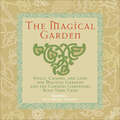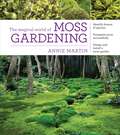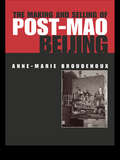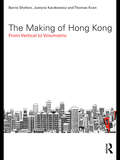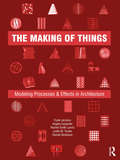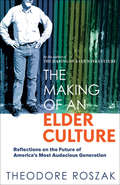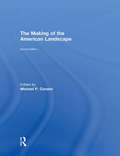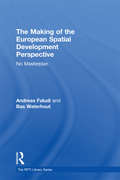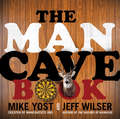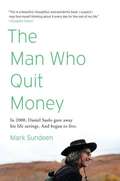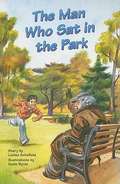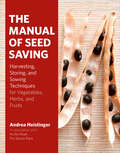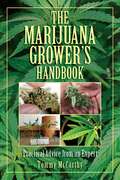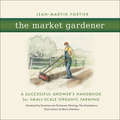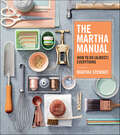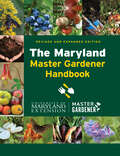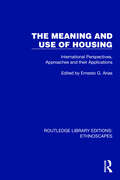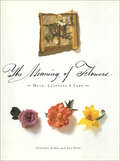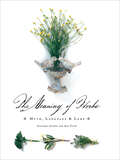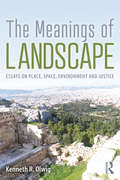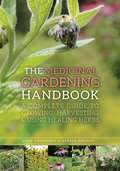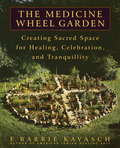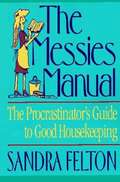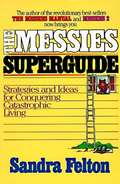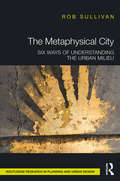- Table View
- List View
The Magical Garden: Spells, Charms, and Lore for Magical Gardens and the Curious Gardeners Who Tend Them
by Denny Sargent Sophia SargentThe Magical Garden is a curious little book of magic, charms, spells, and bits of traditional and historical lore from and for magical gardens and the curious gardeners who tend to them. What gardener would not want to know the flower they were born under, the traditional magical meanings of bells and chimes, or the healing power of geraniums? Many of these nuggets of wisdom and magic have been handed down from Sophia's grandparents, who extensively used herbs and such in their psychic work. Avid gardener and ancient historian Denny Sargent collected much of the information included here from a wide variety of traditional sources. Roman, Celt, Norse, and Japanese gardeners all believed in garden magic, and some of their most fascinating traditions, spells, and charms are contained in this wonderful little book. In addition to the garden, magical plants, birds, insects, the yard, and the weather are also addressed. Other interesting lore includes: Garden sprites, fairies, and elves; Ancient and magical ways for empowering the garden by planting certain plants in special places; Traditions for celebrating festivals in the garden, ways of using garden plants for protection, and techniques for invoking positive energy with trees.
The Magical World of Moss Gardening
by Annie Martin“This is a fascinating books for anyone wanting to truly broaden the range of plants they grow.” —Gardens Illustrated Moss is an extraordinary plant—it grows without roots, flowers, or stems. Despite being overlooked, in many ways, moss is perfect: it provides year-round color, excels in difficult climates, prevents soil erosion, and resists pests and disease. In The Magical World of Moss Gardening, bryophyte expert Annie Martin reveals how moss can be used in stunning, eco-friendly spaces. The beautifully illustrated guide includes basics on designing and planting a moss garden, as an inspiring tour of the most magical public and private moss gardens throughout the country.
The Making and Selling of Post-Mao Beijing (Planning, History and Environment Series)
by Anne-Marie BroudehouxDescribes the changing life of the city and its inhabitants during the final decades of the twentieth century and examines the complex forces at play in the search for modernity. The author presents us with four case studies of how the city is marketing and selling itself (including its refurbishment for the 2008 Olympic bid) and concludes that Beijing's urban image construction may provide an avenue for opposition groups to challenge the hegemony of those in power.
The Making of Hong Kong: From Vertical to Volumetric (Planning, History and Environment Series)
by Thomas Kvan Justyna Karakiewicz Barrie SheltonThis book investigates what the history of Hong Kong’s urban development has to teach other cities as they face environmental challenges, social and demographic change and the need for new models of dense urbanism. The authors describe how the high-rise intensity of Hong Kong came about; how the forest of towers are in fact vertical culs de sac; and how the city might become truly ‘volumetric’ with mixed activities through multiple levels and 3D movement networks incorporating ‘town cubes’ rather than town squares. For more information, visit the authors' website: http://www.makingofhk.com/makingofhk.swf
The Making of Things: Modeling Processes and Effects in Architecture
by Angela Carpenter Frank Jacobus Rachel Smith Loerts Justin M. Tucker Randal DickinsonThe Making of Things is about effect and intention in the schematic architectural model, a deep dive into the nature of architectonic form as the underlying syntax for all architectural work. By focusing on primitive geometries alongside fundamental principles of architectural thinking and making, this book enhances the reader’s capacity to intellectually and physically craft models that effectively communicate intention. With over 650 diagrams, this book acts as an expansive visual glossary that reveals the underlying structure of architectonics and acts as an encyclopedia of formal possibilities. Supporting essays in the book explore the nature of perception, abstraction, and metaphor to provide a theoretical basis of formal effects in architecture. This structure enables readers to make clear and direct connections between the things you construct and the reasons you construct them. This book is a bridge from the what to the why of form-making. It is a pedagogical notebook, a design primer that prompts discourse about the nature of objects. This is a must-have desk reference for beginning architecture and interior design students to stimulate their creative approaches and gain foundational knowledge of the underlying effects of formal typologies and how they manifest themselves in built forms around the world.
The Making of an Elder Culture: Reflections on the Future of America's Most Audacious Generation
by Theodore Roszak"It is a brilliant and highly original thesis. I commend Roszak for writing the book." - Tom Pochari, World Affairs Monthly"...sense of optimisim that comes out in this book, where Roszak champions the possibility of restoring that lost commitment to the ideals of libertion." Tom HartleyThe Summer of Love. Vietnam. Woodstock. These are the milestones of the baby boomer generation Theodore Roszak chronicled in his 1969 breakthrough book The Making of a Counter Culture. Part of an unprecedented longevity revolution, those boomers form the most educated, most socially conscientious, politically savvy older generation the world has ever seen. And they are preparing for Act Two.The Making of an Elder Culture reminds the boomers of the creative role they once played in our society and of the moral and intellectual resources they have to draw upon for radical transformation in their later years. Seeing the experience of aging as a revolution in consciousness, it predicts an "elder insurgency" where boomers return to take up what they left undone in their youth. Freed from competitive individualism, military-industrial bravado, and the careerist rat race, who better to forge a compassionate economy? Who better positioned not only to demand Social Security and Medicare for themselves, but to champion "Entitlements for Everyone"? Fusing the green, the gray, and the just, Eldertown can be an achievable, truly sustainable future.Part demographic study, part history, part critique, and part appeal, Theodore Roszak's take on the imminent transformation of our world is as wise as it is inspired-and utterly appealing.Theodore Roszak is the author of fifteen books, including the 1969 classic The Making of a Counter Culture. He is professor emeritus of history at California State University, and lives in Berkeley, California.
The Making of the American Landscape
by Michael P. ConzenThe only compact yet comprehensive survey of environmental and cultural forces that have shaped the visual character and geographical diversity of the settled American landscape. The book examines the large-scale historical influences that have molded the varied human adaptation of the continent’s physical topography to its needs over more than 500 years. It presents a synoptic view of myriad historical processes working together or in conflict, and illustrates them through their survival in or disappearance from the everyday landscapes of today.
The Making of the European Spatial Development Perspective: No Masterplan (RTPI Library Series)
by Andreas Faludi Bas WaterhoutThe European Spatial Development Perspective (ESDP) is published in eleven official EU languages and so is the most international planning policy document that exists. This book is the only comprehensive account of the process of preparing, negotiating and adopting this document. It outlines the differing perspectives of the European member states and shows that the last thing its proponents wanted is a masterplan. The Making of the European Spatial Development Perspective is a unique book offering a snapshot of contemporary European spatial planning.
The Man Cave Book
by Michael H. Yost Jeff WilserWhat separates the men from the boys? The Man Cave. Boyhood Fort Man Cave Who's allowed Not girls-they have cooties Not women-they have authority Primary materials used in construction Wood, stuff your mom doesn't want Particleboard, stuff your wife doesn't want Key activities inside Goofing around, avoiding responsibility Goofing around, avoiding responsibility Peak periods of use After school, weekends After work, weekends Slumber parties with buddies? Yes No Food and beverages consumed Soda and unhealthy snacks Beer and unhealthy snacks Spend the night inside? Not as a habit, but it's been known to happen Not as a habit, but it's been known to happen Money spent on space As little as possible As much as possible Is this a phase you will outgrow? Yes No The Man Cave Book is a tribute to great and glorious man spaces and the craftsmen behind them. Complete with instructions and insights into creating your own unique refuge and shrine to beer, sports, and everything else that's right with the world, this is an essential manual for any man cave enthusiast.
The Man Who Quit Money
by Mark SundeenA Walden for the 21st century, the true story of a man who has radically reinvented "the good life" In 2000, Daniel Suelo left his life savings; all thirty dollars of it; in a phone booth. He has been living without money; and with a newfound sense of freedom and security; ever since. The Man Who Quit Money is an account of how one man learned to live, sanely and happily, without earning, receiving, or spending a single cent. Suelo doesn't pay taxes, or accept food stamps or welfare. He lives in caves in the Utah canyonlands, forages wild foods and gourmet discards. He no longer even carries an I. D. Yet he manages to amply fulfill not only the basic human needs-for shelter, food, and warmth-but, to an enviable degree, the universal desires for companionship, purpose, and spiritual engagement. In retracing the surprising path and guiding philosophy that led Suelo into this way of life, Sundeen raises provocative and riveting questions about our relationships with money and the decisions we all make, by default or by design; about how we live and how we might live better.
The Man Who Sat in the Park (Rigby PM Plus Non Fiction Ruby (Levels 27-28), Fountas & Pinnell Select Collections Grade 3 Level Q)
by Louise Schofield Suzie ByrneBradley becomes friendly with Stan, an old homeless man in the park. Bradley volunteers to help at the men’s shelter and finds out more about his new friend. Stan makes Bradley a paper boat to sail in the park pond. One day, Stan doesn’t show up in the park and Bradley discovers he has been taken to hospital. When Stan dies, Bradley’s parents give him a model boat to remind him of his friend.
The Manual of Seed Saving: Harvesting, Storing, and Sowing Techniques for Vegetables, Herbs, and Fruits
by Ian Miller Andrea Heistinger“Makes it easy to find information in a snap, on most any edible you want to grow.” —Kylee Baumle, Horticulture Growing vegetables, fruits, and herbs from seed has many benefits for both the gardener and the planet. Why save seeds when you can buy them so cheap? Not only does seed saving allow you to grow a diverse, organic array of fruits and vegetables, it also offers an opportunity to work closely with nature and be even more hands-on with the food you grow, cook, and eat. Supported by research from the global conservation organizations Arche Noah and Pro Specie Rara, The Manual of Seed Saving features information on how to maximize seed quality and yield for crop plants like asparagus, carrots, corn, rhubarb, spinach, squash, and tomatoes. Plant profiles include critical information on pollination, isolation distances, cultivation, harvest, storage, and pests and diseases.
The Marijuana Grower's Handbook: Practical Advice from an Expert
by Tommy MccarthyAnyone can buy marijuana seeds-they are legal to purchase-and with some soil, water, and light, you can grow your own plants. With step-by-step instructions, Tommy McCarthy will show you how to cultivate and raise beautiful hemp plants, as well as how to harvest and prepare the final product.The Marijuana Grower's Handbook will teach you many important steps, including:Choosing the right plants.Knowing which seeds to buy.Nurturing your plants.Harvesting and preparing the final product.Avoiding common mistakes.And more!Growing marijuana should be an enjoyable and satisfying experience. You will be able to watch and enjoy the fruits of your own handiwork and won't have to worry about dedicating much time or expense. Growing marijuana should be enjoyed, and with the tips and tricks included in The Marijuana Grower's Handbook, you will be able to see your time and energy come to fruition in this beautiful and helpful plant.
The Market Gardener: A Successful Grower's Handbook for Small-Scale Organic Farming
by Jean-Martin Fortier&“Few books have grabbed my attention as dramatically as this one—because it&’s ultimately do-able for thousands of would-be food and farm healers.&” —Joel Salatin, Polyface Farm Grow better not bigger with proven low-tech, human-scale, biointensive farming methods Making a living wage farming without big capital outlay or acreages may be closer than you think. Growing on just 1.5 acres, Jean-Martin and Maude-Helene feed more than 200 families through their thriving CSA and seasonal market stands. The secret of their success is the low-tech, high-yield production methods they&’ve developed by focusing on growing better rather than growing bigger, making their operation more lucrative and viable in the process. The Market Gardener is a compendium of proven horticultural techniques and innovative growing methods. This complete guide is packed with practical information on: · Setting-up a micro-farm by designing biologically intensive cropping systems, all with negligible capital outlay · Farming without a tractor and minimizing fossil fuel inputs through the use of the best hand tools, appropriate machinery and minimum tillage practices · Growing mixed vegetables systematically with attention to weed and pest management, crop yields, harvest periods and pricing approaches. Inspired by the French intensive tradition of maraichage and by iconic American vegetable grower Eliot Coleman, author and farmer Jean-Martin shows by example how to start a market garden and make it both very productive and profitable. &“Very well done and should be of great use to market growers everywhere.&” —Eliot Coleman, organic farming pioneer and author of The New Organic Grower &“Both visionary and practical, it is a work of rare intelligence.&” —Charles Herve-Gruyer, permaculture teacher and grower at la Fermedu BecHellouin, France
The Martha Manual: How to Do (Almost) Everything
by Martha Stewart“An easy-to-navigate and attractive guidebook covering a wide array of topics, from organizing the entrance to one’s home to traveling with pets.” —Publishers WeeklyMartha Stewart is America’s go-to source for the best answers to nearly every question. As an authority on the many worlds upon which she’s built her domestic empire, she can advise on everything from creating a cutting garden and setting the table to playing classic lawn games or building a campfire. Whether it’s organizing, celebrating, cleaning, decorating, or any number of other life skills, these are the time-tested, Martha-approved strategies for frequent challenges and basic how-to knowledge that everyone should have at the ready. Also included are plenty of solutions for the not-so-common conundrums, such as how to transport a decorated cake, bathe a cat, or fold an American flag. With hundreds of expert tips and useful insights in an easy-to-follow format, this is the manual you need to learn how to do everything—the Martha way.“This most recent compendium provides everything one might expect from a Stewart manual—clean and elegant design along with detailed instructions. For everyone with similar DIY experiences, and anyone looking to get started.” —Library Journal
The Maryland Master Gardener Handbook
by University of Maryland Extension - Master Gardener ProgramThe definitive guide to gardening in Maryland and the mid-Atlantic—from the experts at the University of Maryland Extension.Whether you're a novice or an expert gardener, The Maryland Master Gardener Handbook is the resource you need to grow a thriving garden in Maryland and the mid-Atlantic region. This reference details plant terminology, gardening instructions, growing schedules, and species charts featuring color photographs for gardeners in Maryland.Chapters cover essential horticultural topics such as ecology, botany, soils, entomology, and plant diseases. In addition to educating gardeners about the basics, the handbook highlights sustainable gardening content such as the use and care of native plants, integrated pest management, water conservation, and best management practices for gardening in a changing climate. Diving deeper, the handbook also provides information on:• Plant nutrition• Composting and pruning• Weeds and lawns• Herbaceous plants and woody plants• Vegetables and fruits• Native plants, invasive plants, indoor plants, and plant propagation• Landscape design and conservation landscaping• Wildlife and woodlands• Garden tools and equipmentFinally, the guide includes diagnostic keys for all major plant groups and special keys for cultural and environmental problems, as well as information on structural and nuisance pests. Created as part of the curriculum of the University of Maryland Extension Master Gardener Program, The Maryland Master Gardener Handbook is the definitive resource for anyone looking to develop a green thumb.
The Meaning and Use of Housing: International Perspectives, Approaches and their Applications (Routledge Library Editions: Ethnoscapes)
by Ernesto G. AriasOriginally published in 1993, as part of the Ethnoscapes: Current Challenges in the Environmental Social Sciences series, reissued now with a new series introduction, The Meaning and Use of Housing presents a re-evaluation of the use and meaning of residential environments. It integrates methodological and philosophical approaches to assist in the making of comparisons across issues, concerns, disciplines and countries, and links theory, research and practice. It spans the globe, reviewing studies of every conceivable form of housing. In these studies a wide range of social science, design, management and policy perspectives are harnessed to enrich our understanding of the central place in people's life, their homes.
The Meaning of Flowers: Myth, Language & Lore
by Ann Field Gretchen ScobleA colorful primer to the symbolism and lore from around the world for over sixty flowers to help you add meaning to any floral gift.Should you send a rose of crimson or of white to the one you love? What gift of flowers best expresses thanks to a dear friend? From ancient days, long before words complicated what we say to one another, flowers have been our messengers, invested with our most cherished feelings.Illustrated with luscious collages by acclaimed artist Ann Field, this enchanting tribute to the power and symbolism of flowers offers a contemporary introduction to an age-old tradition. The text draws on botanical, historical, and mythological sources worldwide, from ancient Rome to Victorian England, from Asia to the Americas, presenting portraits of over sixty blossoms favored for all time. In Persia, for instance, the black medulla of the red tulip was said to represent the lover’s heart, burnt to a coal by love’s passion. To Victorians, lavender signified a broken trust, hollyhocks fertility, and nasturtiums a jest or whimsy.Blending fact, folktale, natural history, and original art, The Meaning of Flowers explores the language and lore of nature’s most intimate and beautiful gifts.
The Meaning of Herbs: Myth, Language & Lore
by Ann Field Gretchen ScobleThe fascinating history and uses of these versatile botanicals through the ages, from love potions to self-care—from the authors of The Meaning of Flowers. &“Take borage for courage. Send a bouquet of yarrow to declare war. Hang a sprig of rue at the door to keep witches at bay.&” Like flowers, herbs are steeped in myth and magic, secrets and lore. For centuries, their powers have been called upon to seduce lovers and dispel witches, send hidden messages and brew potent elixirs, entice the palate and soothe the mind. Illustrated with enchanting collages by acclaimed artist Ann Field, this delightful tribute to the meaning and magic of herbs offers a contemporary introduction to an age-old tradition. The text draws on botanical, mythological, and historical sources worldwide, from ancient Rome to Victorian England, from Asia to the Americas, presenting profiles of over fifty herbs favored through the ages. Blending fact, folktale, natural history, and original art, The Meaning of Herbs explores the language and lore of nature&’s most versatile and powerful gifts.
The Meanings of Landscape: Essays on Place, Space, Environment and Justice
by Kenneth R. OlwigCompiling eighteen authoritative essays spanning an extensive academic career, author Kenneth R. Olwig presents explorations in landscape geography and architecture from an environmental humanities perspective. With influences from art, literature, theatre staging, architecture, and garden design, landscape has come to be viewed as a form of spatial scenery, but this reading captures only a narrow representation of landscape meaning today. This book positions landscape as a concept shaped through the centuries, evolving from place to place to provide nuanced interpretations of landscape meaning. The essays are woven together to gather an international approach to understanding the past and present importance of landscape as place and polity, as designed space, as nature, and as an influential factor in the shaping of ideas in a just social and physical environment. Aimed at students, scholars, and researchers in landscape and beyond, this illustrated volume traces the idea of landscape from the ancient polis and theatre through to the present day.
The Medicinal Gardening Handbook: A Complete Guide to Growing, Harvesting, and Using Healing Herbs
by Dede Cummings Barbara Fahs Alyssa HolmesDig into the world of herbal medicine with this complete guide to cultivating and harvesting plants with healing properties. For thousands of years people have been utilizing herbs and cultivating weeds found to speed the healing of wounds, soothe skin irritations, calm uneasy stomachs, and ward off illnesses. Now you can plan and grow your own garden first aid kit.In these pages, you'll learn the basics of gardening in your backyard-or on your windowsill or porch-including instructions for preparing soil, composting, and weeding. You'll then find detailed descriptions of the twelve most common, easy-to-grow, most useful healing herbs, with instructions for growing, harvesting, and utilizing them. These powerful plants include: Garlic, which boosts immunity, reduces blood pressure, and combats cancer Echinacea, which reduces inflammation, boosts immunity, and has antiviral properties Yarrow, which accelerates the healing of wounds, is an anti-inflammatory, and can relieve PMS symptoms Elderflower, which is an astringent and can relieve arthritis and soothe sore throats Mint, which soothes digestive problems, sweetens breath, and can reduce fevers Elecampane, a respiratory tonic with antibacterial and antifungal properties And more!
The Medicine Wheel Garden: Creating Sacred Space for Healing, Celebration, and Tranquillity
by E. Barrie KavaschThe American Indian medicine wheel was an ancient way of creating sacred space and calling forth the healing energies of nature. Now, drawing on a lifetime of study with native healers, herbalist and ethnobotanist E. Barrie Kavasch offers a step-by-step guide to bringing this beautiful tradition into your own life--from vibrantly colorful outdoor circle designs to miniature dish, windowsill, or home altar adaptations. Inside you’ll find: • Planting guides for medicine wheel gardens in every zone, from desert Southwest to northern woodlands • A beautifully illustrated encyclopedia of 50 key healing herbs, including propagation needs, traditional and modern uses, and cautions • Easy-to-follow herbal recipes, from teas and tonics to skin creams and soaps--plus delicious healing foods • Ideas for herbal crafts and ceremonial objects, including smudge sticks, wind horses, prayer ties, and spirit shields • Seasonal rituals, offerings, and meditations to bless and empower your garden and your friends, and much more Practical, beautiful, and inspiring,The Medicine Wheel Gardenleads us on a powerful journey to rediscovering the sacred in everyday life as we cultivate our gardens . . . and our souls. From the Trade Paperback edition.
The Messies Manual: The Procrastinator's Guide to Good Housekeeping (Messies #1)
by Sandra FeltonDo you panic when unexpected guests arrive? Do you fight an avalanche every time you open a closet door? The Messies Manual will provide humorous, helpful guidance and painless, practical tips you need to break away from chronic messiness! Learn how to organize closets, bathrooms, kitchens and even all those little pieces of paper that you wrote lists on. Sandra Felton even helps make meal planning easier!
The Messies Superguide (Messies #3)
by Sandra FeltonThis hands-on workbook gives you everything you need to live an organized life and create order out of chaos. The author, founder of Messies Anonymous, tells how you can start your own self-support group! Included are: 100 helpful hits for "Messies". thoughts on how to design rooms yourself.
The Metaphysical City: Six Ways of Understanding the Urban Milieu
by Rob SullivanThe Metaphysical City examines the metaphorical existence of the city as an entity to further understand its significance on urban planning and geography. It encourages an open-minded approach when studying cities so as to uncover broader connecting themes that may otherwise be missed. Case studies of New York, Paris, Cairo, Mumbai, Tokyo, and Los Angeles explore a metaphor specific to each city. This multidisciplinary analysis uses philosophical treatises, geographical analysis, and comparative literature to uncover how each city corresponds to the metaphor. As such, it allows the reader to understand the city from six differing points of view. This book would be beneficial to students and academics of urban planning, geography, and comparative literature, in particular those with an interest in a metaphysical examination of cities.
